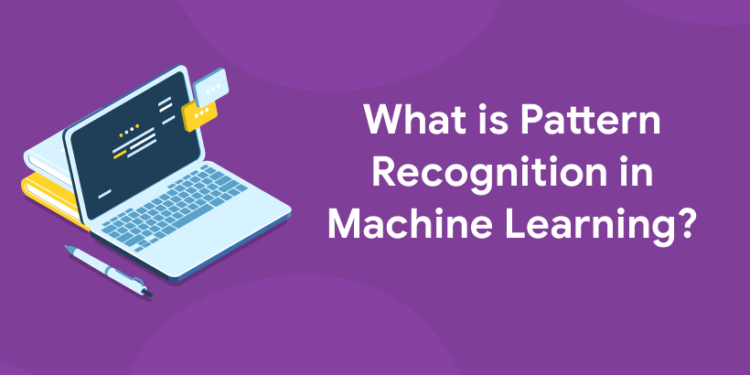Table of Contents
There are patterns everywhere. It is a part of every facet of our everyday existence. Everything incorporates patterns, from the style and color of our clothing to the use of clever voice assistants. The usual question that arises in our thoughts when we claim that everything comprises a pattern or has a pattern is, “What is a pattern?” How can we claim that it includes practically all of our surroundings? How can it be incorporated into the tools that we use every day, the technologies? The solution to all of these issues is really one of the most basic activities that we have all likely been engaged in from infancy. In school, we frequently had to fill in the blank alphabets to guess which number would come next in a series or to connect the dots to finish a figure. Analyzing the pattern that the provided numbers or alphabets followed was necessary for the prediction of the missing number or alphabet. This is what machine learning’s definition of pattern recognition is.
What is Pattern Recognition?
1: Which of the following algorithms is most suitable for classification tasks?
The technique of recognizing trends (global or local) in a given pattern is referred to as pattern recognition. Anything that follows a trend and has some degree of regularity is considered to be a pattern. Pattern recognition can be accomplished physically, theoretically, or by using algorithms. When we discuss pattern recognition in machine learning, we are referring to the use of potent algorithms to find patterns in the provided data. The modern technological fields of computer vision, speech recognition, face identification, etc., heavily rely on pattern recognition.
from novice to pro learn python programming ! enroll now !
Types of Pattern Recognition Algorithms in Machine Learning
1. Supervised Algorithms
A classification describes the supervised technique of pattern recognition. These algorithms find the patterns using a two-step process. The development and building of the model come first, and the prediction of new or undiscovered items comes afterward. Below is a list of this concept’s salient characteristics.
- Partition the given data into two sets- Training and Test set
- Train the model using a suitable machine learning algorithm such as SVM (Support Vector Machines), decision trees, random forest, etc.
- Training is the process through which the model learns or recognizes the patterns in the given data for making suitable predictions.
- Thetest set contains already predicted values.
- It is used for validating the predictions made by the training set.
- The model is trained on the training set and tested on the test set.
- The performance of the model is evaluated based on correct predictions made.
- The trained and tested model developed for recognizing patterns using machine learning algorithms is called a classifier.
- This classifier is used to make predictions for unseen data/objects.
Learn data science and machine learning course with Entri app! Get a free demo
2. Unsupervised Algorithms
These algorithms use a group-by method as opposed to the supervised algorithms for patterns, which employ training and testing set. To generate a forecast, they look for trends in the data and categorize the items depending on how similar their properties, such as dimensions, are. Imagine we had a basket full of various fruits, including apples, oranges, pears, and cherries. We presumptively don’t know the fruits’ names. The data is maintained as unlabeled. Now imagine that we come into a circumstance when someone asks us to recognize a new fruit that has been added to the basket. In this situation, we apply a concept known as clustering.
- Clustering combines or groups items having the same features.
- No previous knowledge is available for identifying a new item.
- They use machine learning algorithms like hierarchical and k-means clustering.
- Based on the features or properties of the new object, it is assigned to a group to make a prediction.
Tools used for Pattern Recognition in Machine Learning
- Amazon Lex – It is an open-source software/service provided by Amazon for building intelligent conversation agents such as chatbots by using text and speech recognition.
- Google Cloud AutoML – This technology is used for building high-quality machine learning models with minimum requirements. It uses neural networks (RNN -recurrent neural networks) and reinforcement learning as a base for model construction.
- R-Studio – For coding, it uses the R programming language. Creating and testing pattern recognition models, it is an integrated development environment.
- IBM Watson Studio – IBM Watson Studio is an open-source tool provided by IBM for data analysis and machine learning. It is used for the building and deployment of machine-learning models on a desktop.
- Microsoft Azure Machine Learning Studio – This Microsoft-provided application uses a drag-and-drop methodology to construct and deploy machine learning models. It provides a model creation and application environment based on a GUI (Graphical User Interface).
Scope of Pattern Recognition in Machine Learning
- Data Mining- It describes the process of extracting valuable information from vast volumes of data coming from many sources. For creating predictions and data analysis, data mining techniques provide relevant data.
- Recommender Systems– Recommender systems are used by the majority of websites that are only focused on online buying. These systems gather information about each client’s purchase and then use machine learning algorithms to find trends in the purchasing patterns of customers.
- Image processing– The image process is basically of two types – Digital Image processing and Analog image processing. Digital image processing uses intelligent machine learning algorithms for enhancing the quality of the image obtained from distant sources such as satellites.
- Bioinformatics – It is a branch of research that makes predictions about biological data using software and computing techniques. Consider the scenario where a novel protein was identified in the lab but its sequence is unknown. In order to anticipate a sequence based on comparable patterns, the unknown protein is compared with a vast number of proteins kept in the database using bioinformatics methods.
- Analysis– Pattern recognition is used for identifying important data trends. These trends can be used for future predictions. An analysis is required in almost every domain be it technical or non-technical. Example of pattern recognition, the tweets made by a person on Twitter help in sentiment analysis by identifying the patterns in the posts using natural language processing.
Learn data science and machine learning course
Advantages of Pattern Recognition
A person can profit much by applying pattern recognition techniques. It aids in trend analysis and forecast-making, among other things.
- It helps in the identification of objects at varying distances and angles.
- Easy and highly automated.
- It is not rocket science and does not require an out-of-the-box thinking ability.
- Highly useful in the finance industry to make valuable predictions regarding sales.
- Efficient solutions to real-time problems.
- Useful in the medical fields for forensic analysis and DNA (Deoxyribonucleic acid) sequencing.
Are you aspiring for a booming career in IT? If YES, then dive in |
||
Full Stack Developer Course |
Python Programming Course |
Data Science and Machine Learning Course |
Importance of Pattern Recognition in Machine Learning
- Even the tiniest of concealed or untraceable data may be found and predicted using pattern recognition.
- It assists in classifying unknown data.
- Using learning approaches generates accurate predictions.
- At various distances, it can identify and distinguish an item.
- It assists in giving meaningful suggestions in addition to assisting in the prediction of previously unobserved facts.
Applications of Pattern Recognition
- Trend Analysis– Identification of patterns enables accurate trend analysis to be performed on the provided data. Future sales, for instance, might be forecasted by looking at current trends in the sales generated by a specific firm or organization.
- Assistance – Our daily lives involve patterns in many ways. It greatly facilitates our daily operations. Today’s market is flooded with software and applications that utilize machine learning algorithms to detect the existence of obstacles and warn the user of potential void misses.
- E-Commerce – Based on its criteria, visual search engines identify the sought-after object and return relevant results. Recommender systems are used by the majority of websites that are only focused on online buying. These programs gather information about each purchase made by a consumer and provide recommendations. Making accurate forecasts requires examining historical trends, which is how all these activities are completed.
- Computer vision– When interacting with the system, the user enters a picture or video as input. To look for patterns, the machine compares it to hundreds, or even millions, of other photos that are saved in its database. An algorithm that is primarily intended for grouping similar-looking items and patterns are used to draw vital characteristics. Computer vision is the phrase used for this. For instance, cancer detection.
- Biometric devices– These gadgets use technology for facial recognition and fingerprint detection to ensure identification and security. Machine learning algorithms serve as the underpinning for the application of technologies like face and fingerprint recognition.
Get a free demo for our certificate program in data science and Machine learning
Related Articles
| Our Other Courses | ||
| MEP Course | Quantity Surveying Course | Montessori Teachers Training Course |
| Performance Marketing Course | Practical Accounting Course | Yoga Teachers Training Course |











